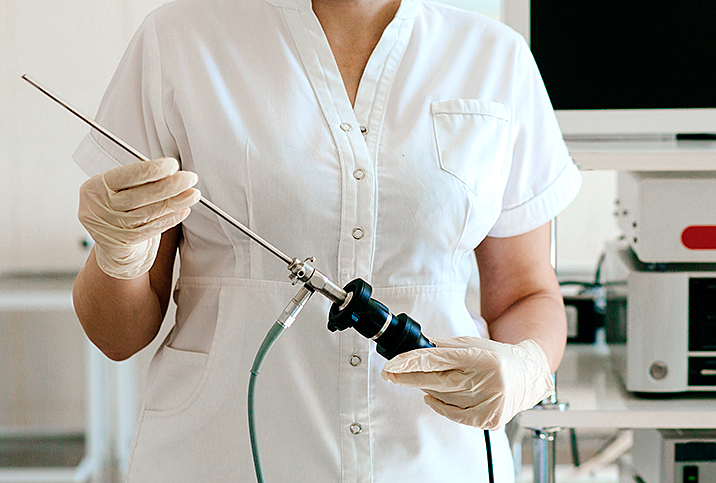Your Infrequent Periods Might Be Functional Hypothalamic Amenorrhea

Functional hypothalamic amenorrhea (FHA), often shortened to hypothalamic amenorrhea (HA), is a medical condition where the signaling from the brain to the ovaries is disrupted and there's no trigger to start follicle development each month. This results in low levels of estrogen and infrequent or no periods.
FHA occurs among menstruators of reproductive age, and the three main causes are severe psychological stress, extreme exercise and disordered eating. It's estimated that 1.62 million women ages 18 to 44 in the United States and 17.4 million women globally suffer from FHA.
According to the American Society of Reproductive Medicine, hypothalamic amenorrhea is responsible for 20 percent to 35 percent of secondary amenorrhea cases. Secondary amenorrhea occurs when a woman experiences three or more missed periods in a row. Pregnancy is the most common cause of secondary amenorrhea, according to Mayo Clinic, but disruption of hormones can also be a cause, which is the case with FHA.
Causes of functional hypothalamic amenorrhea
The hypothalamus plays a key role in the smooth operation of the female reproductive system.
"During the normal menstrual cycle, the hypothalamus produces characteristic pulsatile secretions of follicle-stimulating hormone [FSH] and luteinizing hormone [LH]. The timing of these pulsations is crucial for ovulation to take place," explained Deborah Lee, M.B.Ch.B., a sexual and reproductive health specialist at Dr Fox, an online pharmacy headquartered in Bristol, England.
"FSH stimulates the ovary to produce estrogen, which then thickens the endometrium—the womb lining—so it is suitable for the implantation of a fertilized egg. If no pregnancy occurs, the endometrium is shed at the end of the cycle, giving rise to the monthly period," Lee said.
With hypothalamic amenorrhea, the pulsative secretions of FSH and LH have stopped, resulting in low estrogen levels because there is too little FSH to stimulate the ovary, Lee explained. As a result, the endometrium remains thin and inactive, ovulation does not take place and there is no monthly bleeding. Sometimes, however, there can be irregular cycles and infrequent bleeding.
With hypothalamic amenorrhea, the pulsative secretions of FSH and LH have stopped, resulting in low estrogen levels because there is too little FSH to stimulate the ovary,
Any combination of the three main risk factors might cause a woman to develop FHA, which is why it's common in female athletes.
"The bodies of premenopausal women are not used to living with low levels of estrogen. If it is not treated, living with HA puts a woman at increased risk of cardiovascular disease, premature bone loss [osteopenia and osteoporosis], psychological problems and infertility," Lee said.
This condition is different from age-associated menopause—when periods cease around the age of 50—which is driven by the decrease in ovarian production of estrogen primarily, explained Kathleen Jordan, M.D., chief medical officer at Midi Health, a virtual clinic for women older than 40, headquartered in Menlo Park, California.
The "female athlete triad" of amenorrhea, disordered eating and osteoporosis is often linked to sports that are associated with low body weight, such as running, and subjective scoring, such as gymnastics and figure skating, Jordan said.
"There is concern about the long-term effects of hypothalamic amenorrhea on these female athletes," Jordan continued. "These women are essentially experiencing the toll of menopause at an early age, which we know is associated with bone loss but also associated with a host of other health effects ranging from effects on cardiovascular health, metabolism, hair and skin, sleep and even cognition."
Diagnosis of hypothalamic amenorrhea
HA requires a diagnosis of exclusion because there are so many possible causes, according to Lee.
A diagnosis of functional hypothalamic amenorrhea can be made if an individual has not had a period for three consecutive months, a pregnancy test is negative, and blood tests show estrogen levels are less than 50 picograms per milliliter (pg/mL), and FSH and LH are less than 10 milli-international units per milliliter (mIU/ml).
Additionally, tests to rule out other possible underlying causes should be performed, including tests for thyroid disease, hyperprolactinemia, primary ovarian insufficiency (also called premature ovarian failure) and polycystic ovary syndrome (PCOS).
A full family and social history of the patient should also be taken to better understand all of the contributing factors and provide the best management of the condition, Lee advised.
Treatment of FHA
A combined oral contraceptive (COC) pill may be the first step in treatment because it can stimulate bleeding during the seven days of placebo pills. However, this is a hormonal withdrawal bleed, not a true period.
"It does not help treat the true cause of the problem," Lee said. "Moreover, the estrogen in COC may not help restore bone density, probably because of the relatively strong dose of hormones in the combined pill, which further switch off the HPO [hypothalamic-pituitary-ovarian] axis."
Estrogen therapy may also be used to treat FHA. Hormone replacement therapy (HRT) in the form of a tablet, patch or gel is a better alternative than COC, Lee advised. The HRT should include both estrogen and progesterone if the patient has a uterus. It's important to note that HRT is not a contraceptive, so if a patient is worried about pregnancy, they will need to use an alternative form of protection.
Potential eating disorders also need to be identified and treated, which might require the involvement of a psychiatrist, a specialist dietitian and a psychologist. The patient may need to take medication, such as selective serotonin reuptake inhibitors (SSRIs). Research indicates that the hunger hormone, leptin, has been used with some success, too.
Cognitive behavioral therapy (CBT) may be a successful treatment for women with FHA, according to a small study that assessed 16 women with FHA who were of normal body weight and did not report psychiatric conditions, eating disorders or excessive exercise.
After the 20-week treatment period, the study participants who received CBT had a higher rate of ovarian activity (87.5 percent) compared to the women in the control group who received only observation (25 percent).
Ovulation can also be induced using injections of gonadotropin-releasing hormone (GnRH) agonists, although they need to be given with estrogen for a successful outcome, Lee said. A bone density test may also be used to assess baseline bone density and monitor progress.
To treat the root cause of FHA, "a healthy, well-balanced diet, along with plenty of sleep and a change of lifestyle to destress and improve rest and relaxation, is much needed for the natural return of the menstrual cycle," Lee said.


















